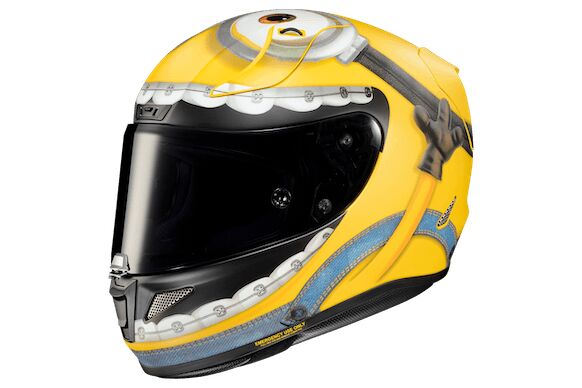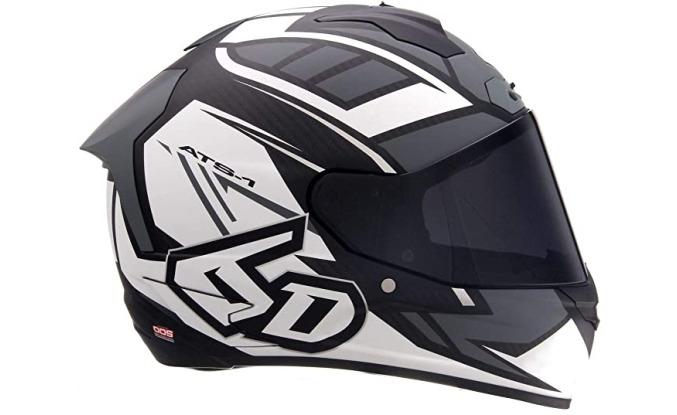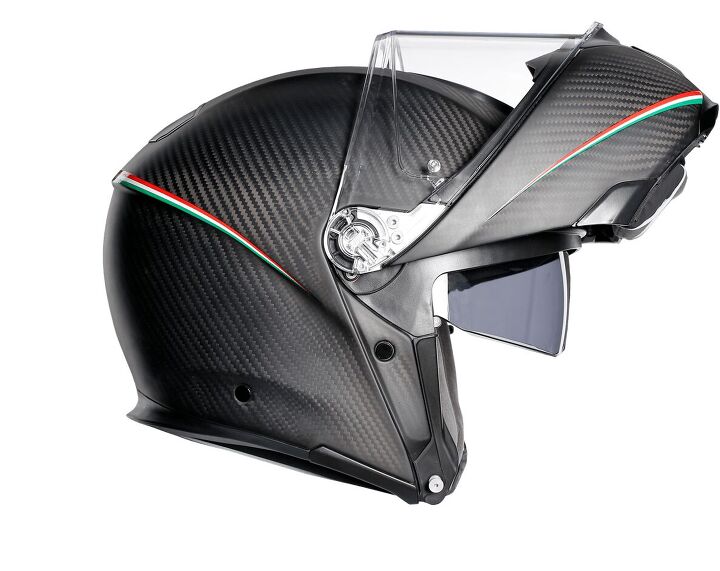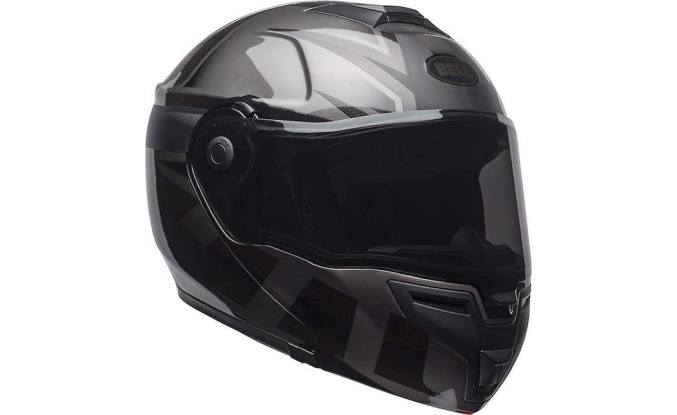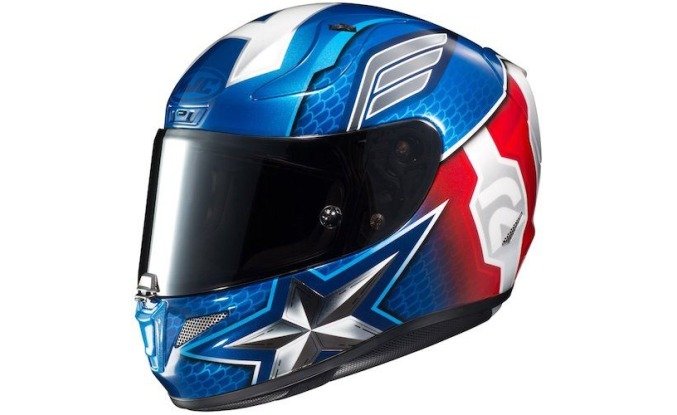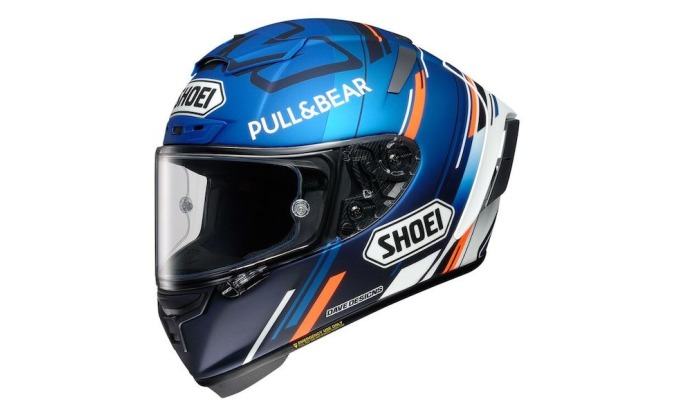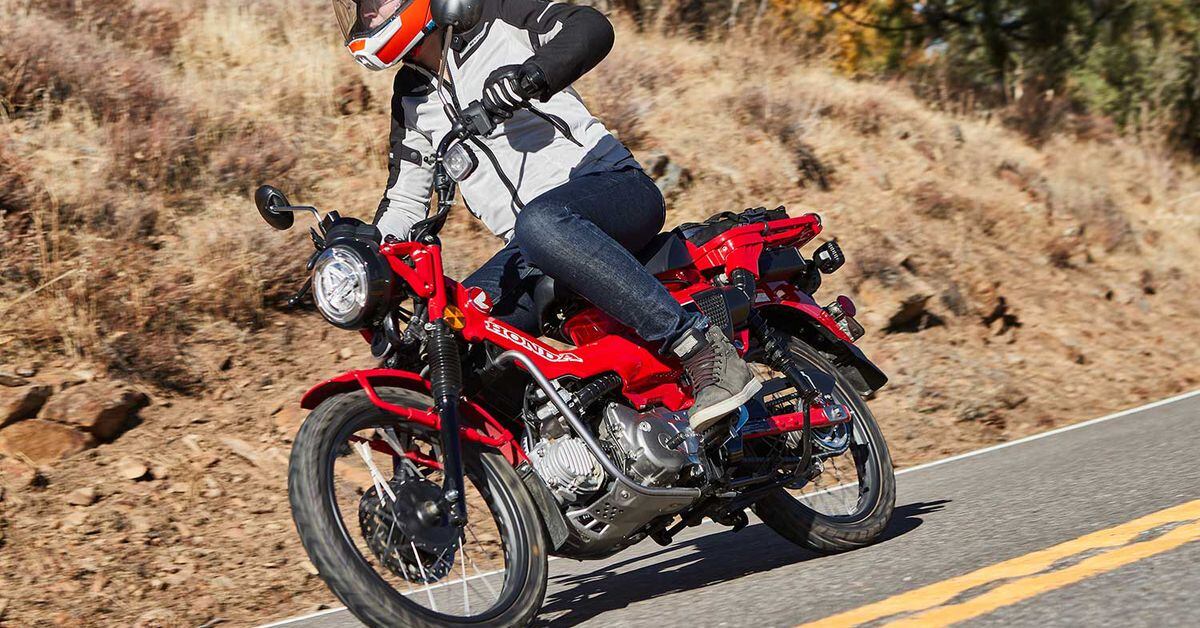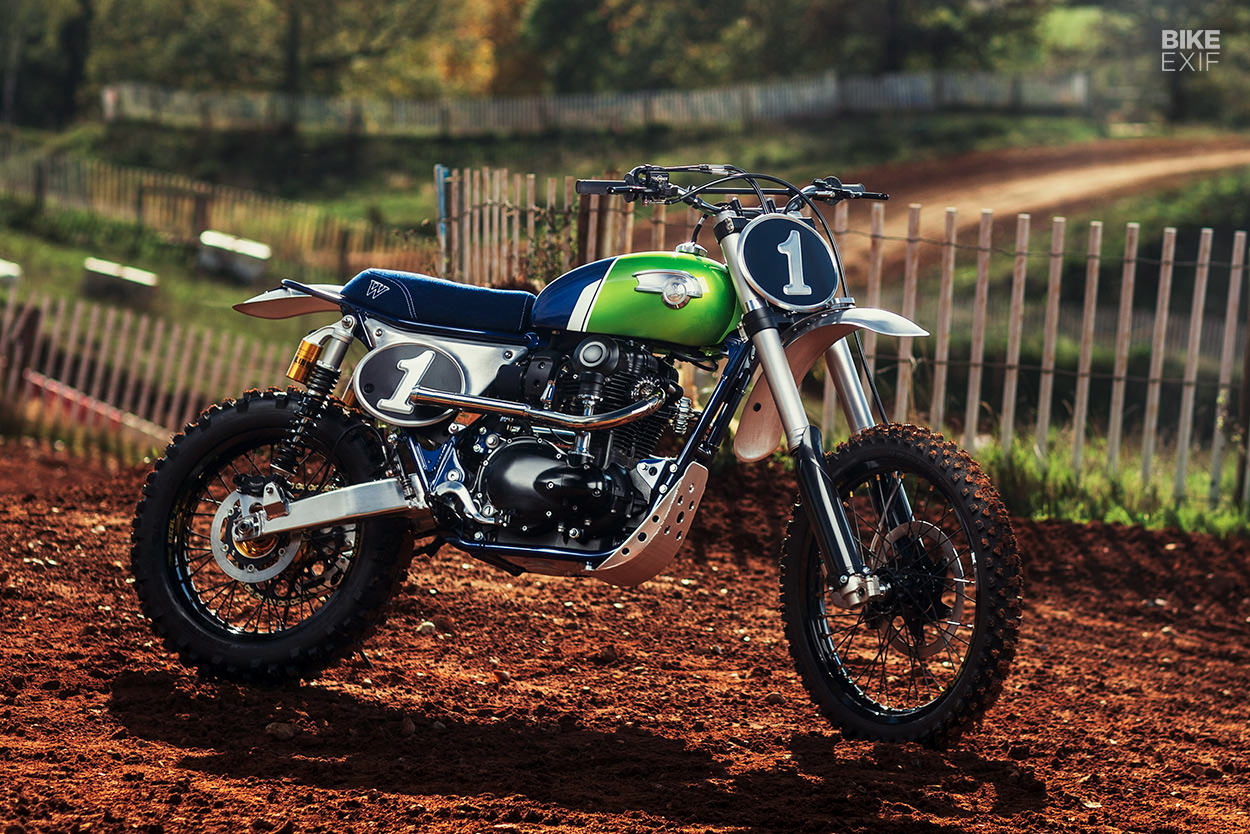Your head really is the most important thing to keep safe, whether you’re on a motorcycle or not, as your ECU is inside it. You don’t have to spend as much as most of these 10 cost for a truly great helmet, but if our mission here is to seek out the best motorcycle helmet, well, you have to open up the purse a little. The following are some of the best money can buy – including some modular options for street riders or those who like the versatility flip-ups provide. And also bear in mind that fit is the number-one determinant in which helmet is best for each individual. If you can try helmets on in a real store, do so, and please give that store a chance to match your best online price. We hereby present what the MO staff collectively agree are the ten helmets that have brought the game forward in terms of safety, comfort, design, practicality, or all of the above.
(Our lead shot is the HJC RPHA11 Pro Otto Minions graphic, available for pre-order now. You’ll find the same excellent lid in Captain America colors below.)
1. 6D ATS-1R
For decades helmet construction was basically the same: a polystyrene shell surrounded your dome and was built to crush upon impact, absorbing the crash force so your head won’t have to. But as motorcycles evolved, helmets didn’t. Until 6D arrived. First came the ATS-1 helmet; now there’s the completely reworked ATS-1R. Using a new and improved version of its ODS (Omni-Directional Suspension) system reduces energy transfer to the head/brain even more than before, says 6D, and makes the R even lighter. Basically, we’ve got tiny springs wedged between two EPS liners, which 6D claims offers unsurpassed security. Read the review here.
Bottom Line/The latest word in protection, according to 6D
2. AGV K-6
The latest thing from Italy is the culmination of all of AGV’s helmet technology focussed onto a single helmet for street use. A super light carbon and aramid fiber shell is formed into an aerodynamic shape that works well on any kind of motorcycle, and its intermediate oval shape and four shell sizes deliver an excellent, snug fit for most heads. A plush Ritmo and Shalimar fabric interior is moisture-wicking, removable and quiet, and the K6’s shield is easily swappable. Solid colors start at $499.
Bottom Line/Haute Italian style and performance for medium money
3. AGV Sportmodular
Weighing in at just a touch over 3.0 pounds, AGV’s Sportmodular is built entirely from Carbon Fiber. AGV says this flip-up meets the same safety standards as its Pista R MotoGP helmet – while weighing less than its racing counterpart! Built for the sport and sport-touring rider, AGV says it spent countless hours in the wind tunnel to make the SportModular aerodynamic and quiet, while still providing good ventilation and stability. Three shell sizes covering XS to XLLL mean everybody should be able to find a comfortable yet compact fit. Read the full MO review here.
Bottom Line/Super-light and aero modular
4. Arai Regent X
Arai’s reputation is second to none when it comes to helmet safety and quality. Two years ago the Corsair-X was in this space, the same helmet the racers wear on MotoGP and WSBK grids. The new-for-2020 Regent X is a lot like the Corsair-X, but designed around a new shell with an even smoother shape. The same plush comfort, protection and features expected of the brand are here but also something else; the Regent is much easier to get on and off your head. The new reinforcing Hyper Ridge and VAS shield system lower the center of gravity, and the bottom of the new shell flares out 5 mm to make getting your head in and out of the helmet easier. It’s a subtle but really noticeable difference that makes the Regent way better to deal with in everyday use than the full-race Corsair. Naturally, the Regent still meets Arai’s own safety standards, which surpass both DOT and Snell. The Regent isn’t cheap, but remembering that every Arai is handmade by an expert craftsman in Japan softens the blow. It’s available in a bunch of solid colors and graphics like the Sensation pictured – and we reviewed it here.
Bottom Line/Handmade Japanese helmet art
5. Bell Race Star Flex DLX
Back in the day, the Bell Star was the helmet to put on your head because it was the only helmet to put on your head. Fast forward a few decades and Bell’s new flagship is the Race Star Flex. Bell’s lightest and most advanced helmet, the Race Star Flex features a 3K carbon fiber shell that makes it light. Helping protect your noggin from impact forces, the Flex design incorporates three different layers of material at different densities – EPO, EPP, and EPS – to best absorb impact from low-, mid-, and high-speed crashes. From there, magnetic cheek pads, a huge field of view (especially when in the tuck position), a sweat-wicking liner, and excellent ventilation all contribute to the helmet’s premium feel. Finally and best of all, DLX denotes that a PanovisioProTint Photochromatic shield is standard equipment. MO’s full review is here.
Bottom Line/Photochromatic shield is the bomb
6. Bell SRT-Modular
Evans Brasfield himself reviewed the Bell SRT-M three years ago, and liked it enough to call it a worthy inclusion to this list of best motorcycle helmets. You can tell a lot of thought went into the design of Bell’s premium modular helmet, even though it doesn’t carry a premium price tag. From its aerodynamic shape, to the vents – even down to the shape of the internal flip-down sun visor and its lip extension that keeps turbulent air from coming underneath the chin bar and aggravating your eyes, this is a great lid. With correctly placed grooves for glasses and pockets for communication systems, Bell thought of everything when it came to designing this practical, flip-front street helmet.
Bottom Line/You could spend more, but…
7. HJC RPHA 11 Pro
RPHA represents the top of the line when it comes to HJC, and the RPHA 11 Pro is the top offering in terms of full-face race helmets from the Korean helmet manufacturer. Lately, HJC is getting notoriety for the wacky graphic designs it’s place on its helmets, a result of the partnerships it has formed with the Marvel, Disney/Star Wars, and Pixar franchises. Pictured is the Marvel-licensed Captain America. The wide price variation is strictly to do with that collaboration. But to focus on that would be to miss an excellent helmet in the RPHA 11 Pro. Constructed from composite materials, the 11 Pro is a surprisingly comfortable helmet with great aerodynamics and ventilation. The RPHA 11 Pro has a lot of the premium features as the others, but comes in at a price point much easier to swallow, if you don’t need the replica graphics. Here’s a John Burns’ review from 2017.
Bottom Line/Express yourself
8. Shoei RF1400
When it comes to a fully-featured street helmet, the Shoei RF name is legendary, and the trend continues in the new-for-2020 RF1400. The new SNELL-certified RF is the latest iteration of the helmet Shoei’s been perfecting since 1984, and it’s lighter, more aerodynamic, quieter, and better ventilated than ever. Dual-density EPS inside a shell that’s a matrix of hand-laid interwoven layers of fiberglass and light-weight organic fibers results in the safest RF ever, as well, in a helmet that fits many intermediate oval heads like none other. Naturally the interior is as plush as you’d expect and completely removable, washable, and customizable. E Brasfield reviewed the new RF1400 here.
Bottom Line/Always a solid bet
9. Shoei Neotec II
In case you haven’t noticed by now, the MO staff loves flip-up helmets. They’re practical and convenient – basically everything we want in an everyday street helmet, and even better for long days traveling. Shoei seems to have the intermediate oval shape down. The field is stacked with great modular helmets (and a couple not-so-great ones), but one of the best we’ve tried is the Neotec II. Several tweaks were made in the wind tunnel to improve the Neotec II over the original Neotec a few years ago, resulting in a modular that’s more aerodynamic, quieter, and comes with improved ventilation. A trifecta of achievements, especially considering the original Neotec was no slouch in any of those departments. For the full scoop on the Neotec II, check out the Brasfield review here.
Bottom Line/Expensive but worth it
10. Shoei X-Fourteen
What, three Shoeis? You said you wanted the best.
If you want to wear what’s on Marc Marquez’s head, then the X-Fourteen is it. The best of the best, the X-Fourteen competes with the other flagship racing helmets out there. With the help of wind tunnel testing, the X-Fourteen is the most aerodynamic X-series model to date, with removable and/or replaceable wings to suit the rider’s needs to specific track types. The wind tunnel also helped with ventilation design, as the six intake ports work in tandem with the six exhaust ports for excellent airflow. There are even ventilation channels designed around the cheek pads to cool the rider in that area. Comfort is a given with the X-Fourteen, as one of the four shell sizes are sure to fit most head shapes, and the patented rotating liner system allows for a better field of vision in a tuck position. Dual-layer, dual-density EPS liner disperses impact energy with the best of them, and the quick-release cheek pads (seen on all Shoei helmets) make it easier for first responders to take off the helmet if they need to tend to you. Read our review from 2016.
Bottom Line/The faster you go, the better it gets
FAQ
How do I know if my motorcycle helmet is safe?
In the US, a real helmet has to pass the Department of Transportation’s inspection and then wear a DOT sticker to prove it. Lots of helmets from Europe have passed CE or ECE tests and wear those stickers (in addition to the DOT one when they’re imported to the US). A Snell sticker indicates an even more rigorous standard, and can start long debates over whether Snell certification makes helmets too stiff for street use. But stickers are all easily faked and if you’re not experienced enough to tell a cheap knock-off from the real thing, the best thing to do is visit a helmet retailer, look around, and ask the knowledgeable people who work there.
Do motorcycle helmets expire?
The Snell Foundation says: Unused helmets stored in good condition do not automatically expire after five years. Replacing helmets every five years is a judgement call based on testing helmets used by the California Highway Patrol by Dr. George Snively. Wear and tear, the simple act of putting on and taking off helmets, damage the comfort pads and energy absorbing foam liner over time. Helmets with worn-out pads are at least one to two sizes larger than helmets in new condition. A poorly fitted helmet makes it more likely that the helmet will shift too much or even come off the head during a crash impact. For these reasons, Snell recommends replacing helmets after five years of normal use.
Shoei’s official word is: A helmet should be replaced 5 years from date of purchase or 7 years from date of manufacture, whichever comes first. This replacement recommendation is based on a consensus by both the helmet manufacturers and safety standards. Glues, resins and other materials used in helmet production can affect liner materials. Hair oils, body fluids and cosmetics, as well as normal “wear and tear” all contribute to helmet degradation. Petroleum based products present in; cleaners, paints, fuels and other commonly encountered materials may also degrade materials used in many helmets possibly degrading performance. Additionally, experience indicates there will be a noticeable improvement in the protective characteristic of helmets over a five-year period due to advances in materials, designs, production methods and the standards. Thus, the recommendation for five-year helmet replacement is a judgment call stemming from a prudent safety philosophy.
So, just because a helmet is old doesn’t mean it’s unsafe if it’s still in good shape. Helmets are kind of like shoes. Your old ones might have plenty of miles left, but you see something flashy and new and have to have it, which is why most helmets get replaced now and then. New helmets also give motojournalists a reason to go on living.
Can you wear any helmet on a motorcycle?
Any helmet is probably better than none at all, but a football helmet isn’t going to keep bugs and rocks out of your eyes like a good full-face motorcycle helmet (or even a bad one), and a bicycle helmet isn’t designed to protect your brain at speeds faster than you’re able to pedal. It’s the EPS liner (expanded polystyrene) inside most motorcycle helmets that absorbs impacts, not the hard outer shell. And most cheap beanies have very little EPS liner if any – usually just a layer of padding. Those helmets might be good to keep your scalp dry in a light rain, but they’re nigh on useless in an actual crash where your head hits the ground hard, or a tree. So yes, in states without helmet laws, you can wear or not wear any helmet, but a real motorcycle helmet offers the most protection by far. Nobody at MO would ride without one.
Recent updates:
AGV K6: New graphics added
HJC RPHA 11 Pro: New graphics added
Shoei RF1400: New model replaces RF1200
Shoei X-Fourteen: New graphics added
Additional resources:
Best Adventure Motorcycle Helmets
Best Motorcycle Racing Helmets
Best Motorcycle Helmets for Harley Riders
We are committed to finding, researching, and recommending the best products. We earn commissions from purchases you make using the retail links in our product reviews and other articles. Learn more about how this works.
Become a Motorcycle.com insider. Get the latest motorcycle news first by subscribing to our newsletter here.
Source link


